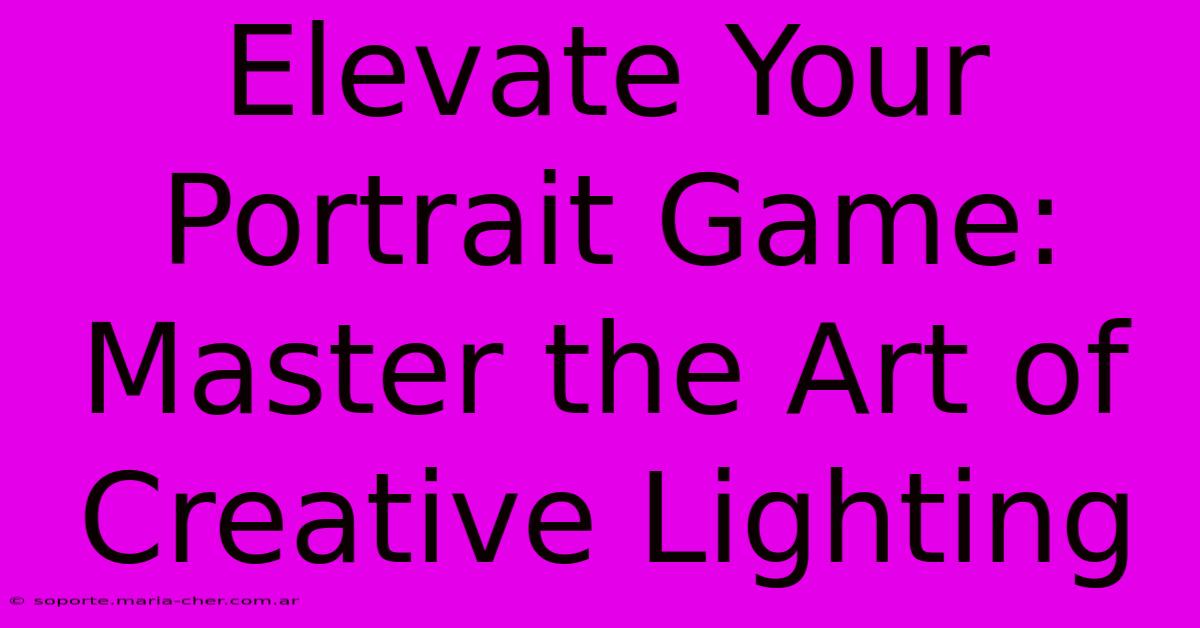Elevate Your Portrait Game: Master The Art Of Creative Lighting

Table of Contents
Elevate Your Portrait Game: Master the Art of Creative Lighting
Photography is all about light, and this is especially true when it comes to portraiture. A well-lit portrait can transform a good photo into a masterpiece, conveying emotion, mood, and personality with stunning visual impact. This comprehensive guide will dive into the art of creative lighting, equipping you with the knowledge and techniques to elevate your portrait photography to the next level.
Understanding the Fundamentals of Light
Before exploring creative lighting techniques, let's solidify our understanding of the core principles:
Quality of Light:
- Hard Light: Creates strong shadows and high contrast. Ideal for dramatic portraits, but can be harsh on the subject's features. Think midday sun or a bare bulb flash.
- Soft Light: Diffuses light, minimizing shadows and resulting in a softer, more flattering look. Overcast days or diffused flash provide soft light.
Direction of Light:
The direction of your light source drastically alters the mood and feel of your portrait.
- Frontal Lighting: Evenly illuminates the subject, minimizing shadows but can sometimes result in a flat image.
- Side Lighting (Rembrandt Lighting): Creates a triangular highlight on the shadowed side of the face, adding depth and drama. A classic and very flattering technique.
- Back Lighting: Places the light source behind the subject, creating silhouettes or dramatic rim lighting, highlighting hair and shoulders. Requires careful exposure control.
- Top Lighting: Creates shadows below the eyes and nose, which can be unflattering unless carefully controlled. Useful for creating a more dramatic or mysterious feel.
Color Temperature of Light:
The color temperature of light (measured in Kelvin) impacts the overall mood and feeling of the image.
- Warm Light (lower Kelvin): Creates a cozy, inviting atmosphere. Often associated with sunsets and candlelight.
- Cool Light (higher Kelvin): Feels crisp, clean, and modern. Think overcast days or daylight balanced flash.
Creative Lighting Techniques for Stunning Portraits
Now that we've covered the basics, let's explore some creative lighting techniques to enhance your portraits:
Using Natural Light:
Harnessing natural light is a cost-effective and beautiful way to achieve stunning results. Experiment with:
- Golden Hour: The hour after sunrise and the hour before sunset, offering warm, soft, and directional light.
- Blue Hour: The period immediately after sunset or before sunrise, providing a cool, moody ambiance.
- Overcast Days: Diffused light creates soft shadows and even illumination, excellent for portrait photography.
Mastering Artificial Light:
Artificial light sources offer more control over the lighting setup.
- Speedlights/Strobes: Versatile and powerful, these allow for precise control over light intensity, direction, and color. Experiment with light modifiers like softboxes, umbrellas, and beauty dishes to shape your light.
- Continuous Lighting: LED lights provide constant illumination, useful for video and allowing you to see the effect of your lighting in real-time.
Light Modifiers: Your Secret Weapon
Light modifiers are essential tools for shaping and diffusing your light source.
- Softboxes: Create a soft, even light, ideal for portraits.
- Umbrellas: Provide a softer light than bare flash but are generally less directional.
- Beauty Dishes: Create a more focused, flattering light with a circular catchlight in the eyes.
- Reflectors: Bounce light back onto the subject, filling in shadows and adding brightness.
Composition and Posing: Completing the Picture
While lighting is paramount, remember that composition and posing play crucial roles in a successful portrait.
- Rule of Thirds: Place your subject off-center to create a more visually appealing image.
- Leading Lines: Use lines within the scene to guide the viewer's eye towards your subject.
- Posing: Guide your subject into natural and flattering poses, paying attention to body language and expression.
Practice and Experimentation: The Key to Mastery
The art of creative lighting in portrait photography is a journey of continuous learning and experimentation. Don't be afraid to try new techniques, explore different light sources and modifiers, and most importantly, have fun! The more you practice, the better you'll become at understanding how light interacts with your subject, resulting in captivating and unforgettable portraits.
This article provides a strong foundation in the art of creative lighting for portraits. By understanding the principles outlined and experimenting with different techniques, you will significantly enhance your photography skills and create truly stunning images. Remember to keep practicing, analyzing your results, and refining your techniques to consistently elevate your portrait game.

Thank you for visiting our website wich cover about Elevate Your Portrait Game: Master The Art Of Creative Lighting. We hope the information provided has been useful to you. Feel free to contact us if you have any questions or need further assistance. See you next time and dont miss to bookmark.
Featured Posts
-
La Signification Secrete Du Logo Dior De La Haute Couture A L Art
Feb 04, 2025
-
Adios Heic Hola Jpg Convierte Archivos Por Lotes Con Nuestra Herramienta Magica
Feb 04, 2025
-
The Sporting Elite Who Are The 1 Of Highest Paid College Athletes
Feb 04, 2025
-
Unlock The World Of Opportunities Perry Homes Employment Hub
Feb 04, 2025
-
Gifs The Nightmare Of Web Performance Not Anymore
Feb 04, 2025
